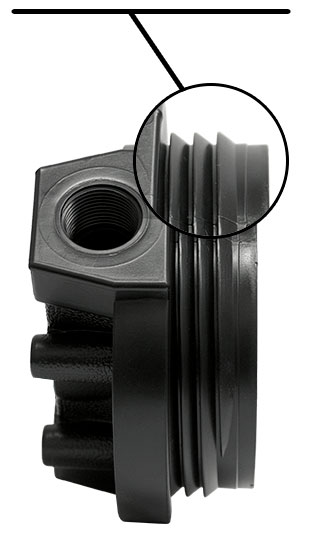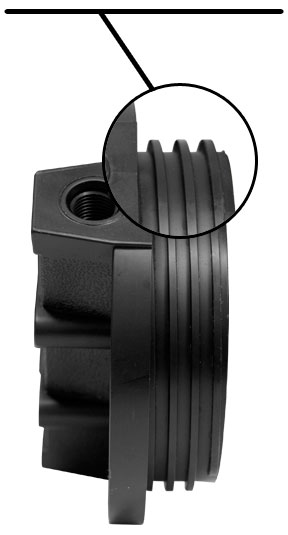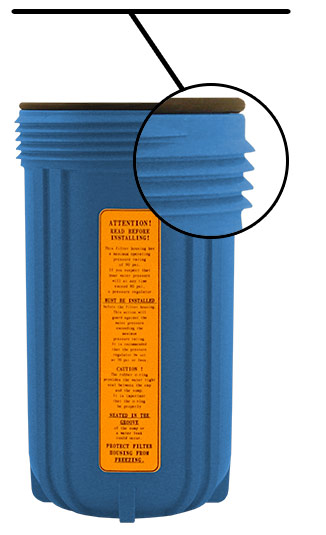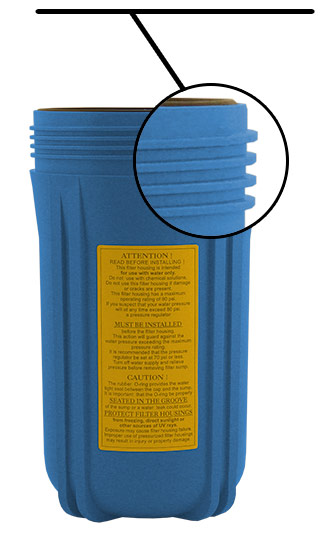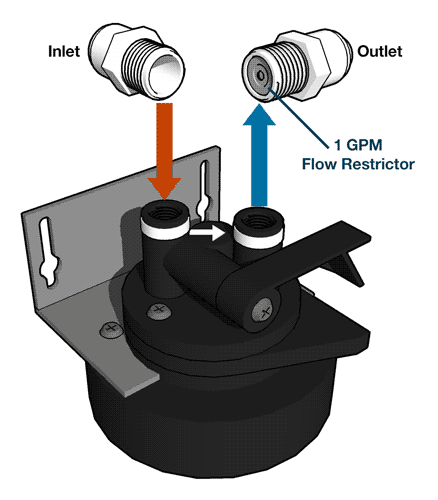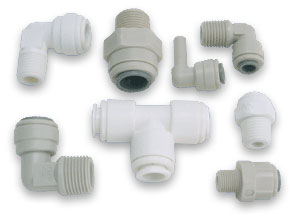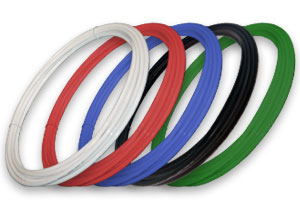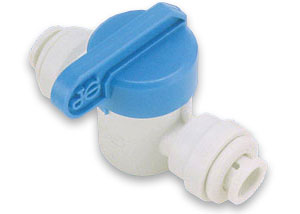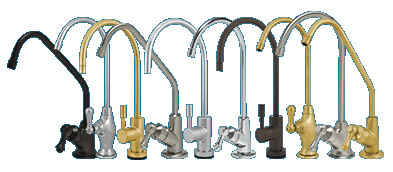Water Filtering Glossary
Abbreviations
- µ Micron
- BB Big Blue (Cartridge diameter of 4-1/2")
- CBC Carbon Block Cartridge
- CTS Copper Thread Size
- FNPT Female National Pipe Thread
FPT Female Pipe Thread - GAC Granular Activated Carbon
- GPD Gallons Per Day
- GPM Gallons Per Minute
- ID Inner Diameter
- JG John Guest
- KDF Kinetic Degradation Fluxion, A type of filtration media
- MNPT Male National Pipe Thread
MPT Male Pipe Thread - NPT National Pipe Thread
- NSF National Sanitation Foundation
- OD Outer Diameter
- NTU Nephelometric Turbidity Unit
- POE Point of Entry
- POU Point of Use
- PP Polypropylene
- PPM Parts Per Million
- QC Quick-Connect
- RO Reverse Osmosis
- SS Stainless Steel
- TDS Total Dissolved Solids
- TFC Thin Film Composite
- TFM Thin Film Membrane
- UF Ultrafiltration
- UV Ultraviolet
Acetal
Polyoxymethylene (POM), also known as acetal, polyacetal and polyformaldehyde, is an engineering thermoplastic used in precision parts requiring high stiffness, low friction and excellent dimensional stability
Activated Carbon
Activated carbon media is a high purity Granular Activated Carbon that can be made from coconut shells, bituminous coal or bamboo, and is utilized for enhanced elimination of impurities and solvents.
Air Gap (Faucet)
The drain water comes from the reverse osmosis system up to faucet and then it passes through an air gap. The water then goes into a different line which is connected to the drain. The air gap provides protection from drain water backing up into the RO System.
Backflow
A backflow prevention assembly is used to protect potable water supplies from contamination or pollution due to backflow. In water supply systems, water is normally maintained at a significant pressure to enable water to flow from the tap, shower etc. When pressure fails or is reduced, as may happen if a water main bursts, pipes freeze or there is unexpectedly high demand on the water system, then such reduced pressure in the pipe may allow contaminated water from the ground, from storage or from other sources to be drawn up into the system.
Backwash
To keep water treatment filters functional, they have to be cleaned periodically to remove particulates. Ineffective backwashing is one of the main reasons that water treatment filters fail. In terms of water treatment, including water purification and sewage treatment, backwashing refers to pumping water backwards through the filter media, sometimes including intermittent use of compressed air during the process. Backwashing is a form of preventive maintenance so that the filter media can be reused.
Bacteriostatic
A bacteriostatic agent or bacteriostat, abbreviated Bstatic, is a biological or chemical agent that stops bacteria from reproducing, while not necessarily harming them otherwise. Depending on their application, bacteriostatic antibiotics, disinfectants, antiseptics and preservatives can be distinguished. Upon removal of the bacteriostat, the bacteria usually start to grow again. This is in contrast to bactericides, which kill bacteria.
Bladder Tank (Storage Tank)
Bladder tanks maintain a supply of high quality water, ready to use anytime you need it. Purified water enters and exits the tank through the same tube. Feed water pressure forces water into the tank. Opening the faucet relieves the pressure and reverses the flow, allowing water to flow through the post-filter and out of the faucet. The reverse osmosis (RO) bladder tank is pre-pressurized with 7 to 8 lbs. of air. Air pressure does not normally need to be checked or changed. The tank can operate on its base or on its side.
Carcinogen
A carcinogen is any substance, radionuclide, or radiation that is an agent directly involved in causing cancer.
Charcoal Filter (Media)
A common misnomer of activated carbon media (See: Activated Carbon)
Check Valve
Check Valves allow the flow of water only in one direction to prevent backflow.
Coconut Shell (Media)
(See: Activated Carbon)
Crosslink (Resin)
Cation resin is made with a polymer, a substance or material consisting of very large molecules called macromolecules, composed of many repeating subunits. The polymer is what gives a resin bead its structural integrity, which is referred to as crosslink. The higher the crosslink percentage, the stronger the resin is.
Cryptosporidiosis
Cryptosporidiosis is a disease caused by the parasite Cryptosporidium parvum, which as late as 1976 was not known to cause disease in humans. Until 1993, when over 400,000 people in Milwaukee, Wisconsin, became ill with diarrhea after drinking water contaminated with the parasite, few people had heard of either Cryptosporidiosis or the single-celled protozoan that causes it.
Dosage (UV Radiation)
Dosage refers to the measurable germicidal effectiveness of ultraviolet light on microorganisms. This is determined by the the turbidity (clearness) of the water, distance from and intensity of the UV light and exposure time, or:
UV dose = UV intensity x time in seconds.
Granular Activated Carbon (GAC)
GAC is activated carbon media and has an extremely large amount of adsorption surface area.
Gallons Per Day (GPD)
A measurement of how much product water a system can produce in a day.
Gallons Per Minute (GPM)
A measurement of how much product water a system can produce in a minute.
Hard Water
Water hardness is the most common problem found in the average home. Hard water is water that contains dissolved hardness minerals above 1 GPG. Calcium, Magnesium, and Lime are the most common minerals in hard water.
Hexavalent Chromium (Chromium 6)
Hexavalent chromium (CrVI or Chromium 6) is a group of chemical compounds containing the element chromium that is odorless and tasteless. It is used in the production of stainless steel, textile dyes, wood preservation, leather tanning, and a variety of other applications. Hexavalent chromium is a probable carcinogen and was brought to national attention when it was found in the drinking water supply of the southern California town of Hinkley, and the subsequent involvement of Erin Brockovich.
Hydrologic Cycle (Water Cycle)
The Hydrologic Cycle (also called the Water Cycle) is the continuous movement of water in the air, on the surface of and below the Earth.
Inline
Inline filters can be installed directly on the water line. These filters are often used as a Reverse Osmosis (RO) inline post filter. They clip on to the membrane housing and filter the water after the bladder tank, acting as a polishing filter.
KDF (Kinetic Degradation Fluxion, Filter Media)
KDF 55 Media is used in chlorine removal applications in conjunction with granular activated carbon. KDF 55 strips the chlorine from the water before the water contacts the carbon. The carbon, not being burdened with the job of chlorine removal is then free to perform higher level carbon filtration. Such as removal of chemical contaminants including Volatile Organic Chemical (VOC’s) and Trihalomethanes (THM’s). KDF 85 Media is used for removal of iron and sulfur from well water. It regenerates with a thorough backwash of water. No chemicals required.
Media
Media is a loose material such as granular activated carbon or KDF that is encased in a housing and used in water filter systems.
Membrane
The reverse osmosis membrane (thin film composite membrane) reduces dissolved minerals, metals, and salts. In this process, harmful compounds are separated by the membrane from the water, and the contaminants are flushed to the drain.
Microfiltration
Microfiltration is a pressure-driven separation process where a contaminated fluid is passed through a special pore-sized membrane filter to separate microorganisms and suspended particles from process liquid.
Micron (µ)
Micron (officially called micrometer) is a unit of length that is one-millionth of a meter and is a common unit of measurement for wavelengths of infrared radiation as well as sizes of cells and bacteria. In water filter cartridges the micron refers to the pore size of the cartridge. Micron is sometimes referred to with the µ symbol.
Nanofiltration
Nanofiltration is a relatively recent membrane filtration process used most often with low total dissolved solids water such as surface water and fresh groundwater, with the purpose of softening (polyvalent cation removal) and removal of disinfection by-product precursors such as natural organic matter and synthetic organic matter
National Pipe Thread (NPT)
A set of technical standards for screw threads used on threaded pipes and pipe fittings in the U.S., known officially as American National Standard Pipe Thread standards. Female and Male pipe threads may be abbreviated as FNPT and MPT (or MNPT) respectively.
NSF (Certification)
NSF International, a not-for-profit, non-governmental organization, is the world leader in standards development, product certification, education, and risk-management for public health and safety.
Nephelometric Turbidity Unit (NTU)
Nephelometric Turbidity Unit is a measurment of the turbidity of water. Turbidity is the cloudiness or haziness of a fluid caused by large numbers of individual particles that are generally invisible to the naked eye, similar to smoke in air. The measurement of turbidity is a key test of water quality. The human eye can detect down to 3 NTU in water.
Particulate
Solid materials suspended in water.
Parts Per Million (PPM)
Unit of measurement and is the relative abundance of dissolved minerals or pollutants in water.
pH
A measure of the acidity or alkalinity of a solution, numerically equal to 7 for neutral solutions, increasing with increasing alkalinity and decreasing with increasing acidity. The pH scale commonly in use ranges from 0 to 14.
Point of Entry (POE) & Point of Use (POU)
A desciptor of a water filter system’s location based on it’s intended use. Point of entry (POE) filters are whole house or water softener systems and are installed near where the water enters the home, usually the basement, treating all of the water in the house. Point of use (POU) filters are located near where the water will be used, like a shower filter on a shower head or an under sink system in a cabinet under the kitchen sink.
Polishing
The term water polishing can refer to any process that removes small (usually microscopic) particulate material, or removes very low concentrations of dissolved material from water. The process and its meaning vary from setting to setting.
Polypropylene (PP)
Polypropylene (PP), also known as polypropene, is a thermoplastic polymer used in a wide variety of applications including packaging and labeling, textiles (e.g., ropes, thermal underwear and carpets), stationery, plastic parts and reusable containers of various types, laboratory equipment, loudspeakers, automotive components, and polymer banknotes. An addition polymer made from the monomer propylene, it is rugged and unusually resistant to many chemical solvents, bases and acids.
Potable Water
Water that is fit or suitable for drinking.
Quick-Connect (QC)
Quick-connect is a connection type that requires no tools to connect or disconnect. Quick-connect works on the same principle as a Chinese finger trap, where pulling away from the connection tightens its grip on the tubing.
Rejection
Rejection is the percentage rate at which a filter will block contaminants and particulates from passing through.
Resin
An ion-exchange resin (or ion-exchange polymer) is an insoluble matrix (or support structure) normally in the form of small (1-2 mm diameter) beads, usually white or yellowish, fabricated from an organic polymer substrate. The material has a highly developed structure of pores on the surface of which are sites with easily trapped and released ions. The trapping of ions takes place only with simultaneous releasing of other ions; thus the process is called ion-exchange.
Reverse Osmosis (RO)
Reverse osmosis (RO) is a membrane-technology filtration method that removes many types of large molecules and ions from solutions by applying pressure to the solution when it is on one side of a selective membrane. The result is that the solute is retained on the pressurized side of the membrane and the pure solvent is allowed to pass to the other side.
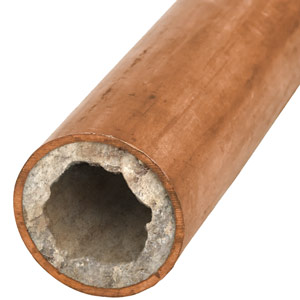
Hard water scale build-up in pipe.
Scale
Rust and corrosion products adhering to the inner surfaces of pipes; serve to decrease ability to transfer heat and to increase the pressure drop for flowing fluids.
Sediment
Sediement is matter present in a water supply, commonly dirt or sand, that enters the water due to aging pipes.
Softening
Water softening is the removal of calcium, magnesium, and certain other metal cations in hard water. The resulting soft water is more compatible with soap and extends the lifetime of plumbing. Water softening is usually achieved using ion-exchange resins.
Total Dissolved Solids (TDS)
The total weight of the solids that are dissolved in the water, give in ppm per unit volume of water. Total dissolved solids (TDS) is determined by filtering a given volume of water (usually through a 0.45 micron filter), evaporating it at a defined temperature (usually 103-105 degrees Celsius), and then weighing the residue. TDS meters can also be used to measure total dissolved solids.
Thin Film Membrane (TFC or TFM)
Thin film composite membranes (TFC or TFM) are semi permeable membranes manufactured principally for use in water purification or water desalination systems. They also have use in chemical applications such as batteries and fuel cells.
Ultrafiltration (UF)
Ultrafiltration (UF) is a variety of membrane filtration in which hydrostatic pressure forces a liquid against a semipermeable membrane. Suspended solids and solutes of high molecular weight are retained, while water and low molecular weight solutes pass through the membrane. This separation process is used in industry and research for purifying and concentrating macromolecular solutions, especially protein solutions. Ultrafiltration is not fundamentally different from microfiltration, nanofiltration or gas separation, except in terms of the size of the molecules it retains.
Ultraviolet (UV)
Ultraviolet light is at the invisible, violet range of the electromagnetic spectrum. The water treatment industry uses a high-powered form of UV light called UV-C or “germicidal UV” to disinfect water.
Water Hammer
Water Hammer (also called hydraulic shock or fluid hammer) is a surge of pressure in a water pipe caused by a few reasons, such as a valve being closed downstream of flowing water. The result is a shock wave that can cause noise, vibration, pipe rupture and equipment damage. Damage from such events can be mitigated by re-establishing the natural air pockets in your plumbing system or with various devices, such as a water hammer arrestor, which acts as a shock absorber from sudden pressure changes. Read more about water hammer at How Stuff Works or view a video explaining how water hammer occurs.
Whole House
Whole house systems filter water at the point of entry into a home and are designed to remove contaminants such as iron, sulfur and manganese as well as dirt and sediments.

